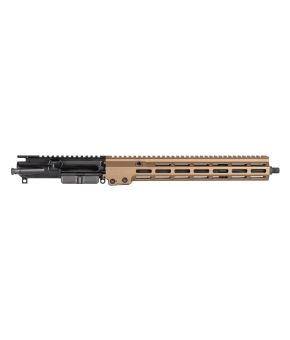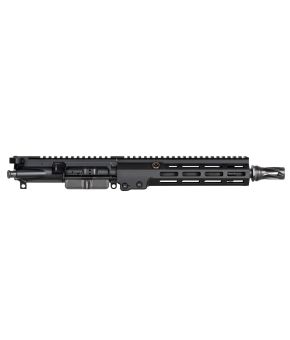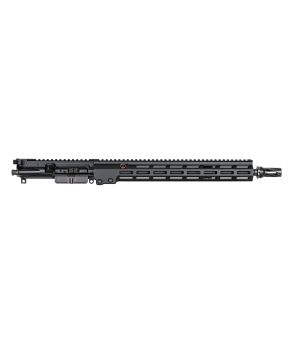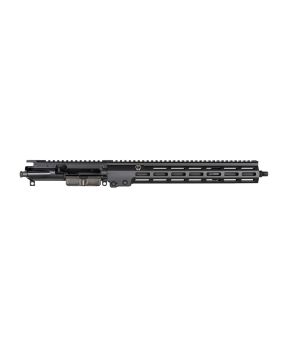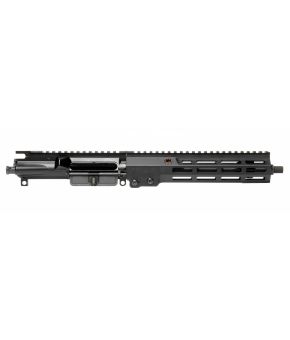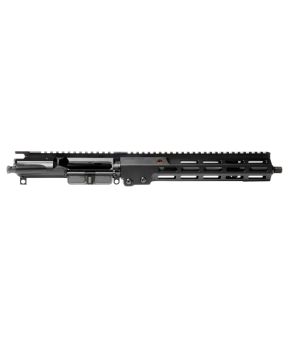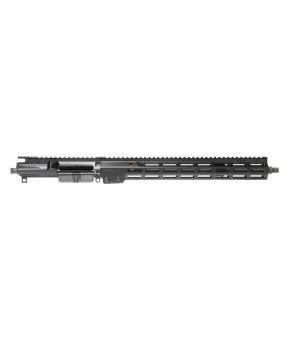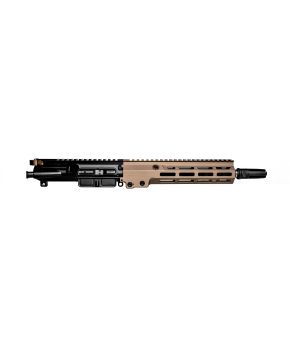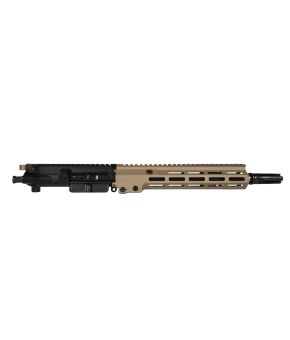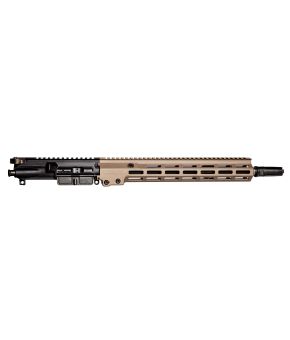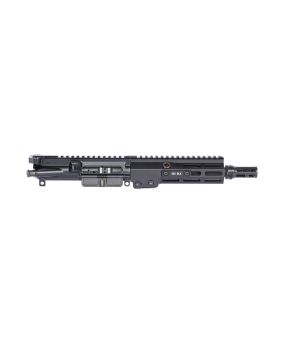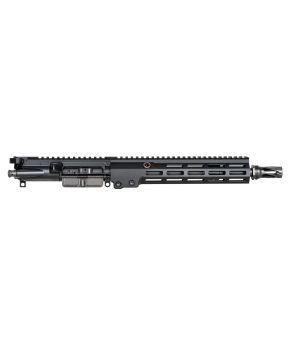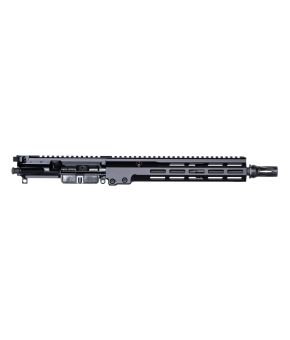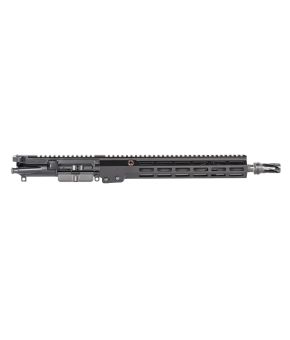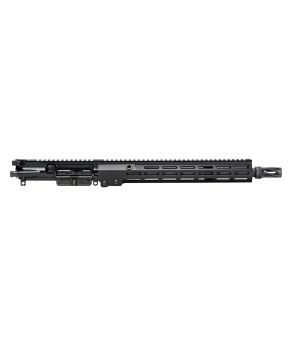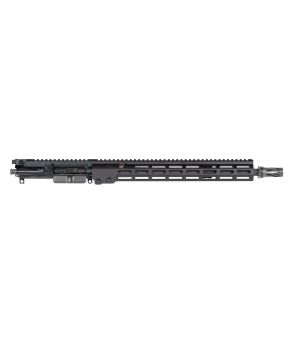Upper Receiver Groups
Subscribe to RSS FeedAR-15 Complete Upper Receivers Groups
Looking for a top-quality AR-15 upper receiver? Whether this is your first AR build or you’re a seasoned pro, you’ll find the highest quality firearm components at Geissele Automatics.
We offer a wide selection of AR-15 complete upper receivers groups in 8", 10.3”, 11.5”, 12.5", 13.9", 14.5”, and 16” and in anodized colors such as classic black and Desert Dirt Color. Our receiver sets are made to the highest military standards and are designed to handle dust, dirt, and mud found in adverse conditions.
What Is An AR-15 Upper Receiver?
An upper receiver is part of the semi-automatic firearm that houses the bolt carrier group, charging handle, and barrel, connecting these components to the lower receiver. Specifically, the upper and lower receivers are the two major groups that comprise an AR-15-style firearm.
What’s The Difference Between An AR-15 Complete Upper vs. Stripped Upper?
When building an AR-15, you can choose a stripped upper receiver or a complete upper receiver group. While a stripped upper receiver is only the receiver component itself, a complete upper receiver group contains all of the elements needed to attach to a lower receiver and create a functioning AR.
In addition to the upper receiver itself, an AR-15 complete upper receiver group typically includes a handguard, barrel, gas system, BCG, and charging handle, as well as an ejection port cover, forward assist, and muzzle device installed on the upper receiver.
How Is An Upper Receiver Made? Billet Upper vs. Forged Upper
A billet upper refers to the material; it is an upper receiver that is made from a single piece of bar stock aluminum. The modern method of creating a billet upper is to use a CNC machine. The aluminum is placed into the machine, where it is sculpted into the size and shape needed.
A forged upper receiver is made by heating up the aluminum and hammering it into a rough receiver shape. Once it has the desired shape, it is placed into a CNC machine and finished.
While billet and forged uppers are both machine-finished and made from the same materials, the difference between the two comes down to the aesthetics and physical features of the final product.
Forged uppers are considered the stronger of the two because the forging process allows the metal grain to follow the shape of the receiver and provide continuous grain characteristics.
Because forged uppers are the industry standard when it comes to AR’s, they generally won’t have compatibility issues. Billet uppers, on the other hand, are made with extra material to add strength around stress points, which can affect the outer dimensions and might cause compatibility issues with parts that are designed for mil-spec uppers.
Geissele uppers are forged, not machined, from bar stock (billet). Utilizing forged uppers allow us to optimize the grain structure of the steel for top strength and durability.
Geissele upper receivers are made out of alloy aluminum and finished in a Type 3 hard coat anodizing for optimal abrasion and chemical resistance.
Types of AR-15 Upper Receivers: Carry Handle vs. Flat Top
For the AR-15, there are two different types of upper receivers: a carry handle and a flat top. The carry handle gets its name from the fixed handle it includes on top of the upper, while the flat top has a picatinny rail on top of the upper instead.
The main difference between a carry handle upper receiver and a flat top upper receiver is the presence of a handle. Carry handles are often seen on early M16 variants since their introduction during the Vietnam War and feature an integral carrying handle for ease of transport. The handle houses the rear sight of the iron sights, which can be effective out to distances of 300 meters or more.
Flat-top receivers offer more versatility, as the top portion does not contain a handle, allowing more space for mounting optics, lights, and other accessories. It also removes the integral Iron sights, which may need to be replaced with detachable sights if needed.
How to Choose an AR-15 Upper Receiver
When choosing an upper receiver, the most important thing to focus on is quality. Unlike other manufacturers, we do not use bulk manufacturing methods at Geissele Automatics.
We build our firearms and firearm components in-house to deliver premium quality products that offer optimal performance and durability. We also offer a limited lifetime warranty, including defects in materials or workmanship. That’s how confident we are in our products.
Other factors to consider when choosing an upper receiver are the ultimate goals for your build, and your budget. There is no one-size-fits-all answer when it comes to choosing an upper receiver group for your AR-15. Put in the time and effort to do the research, and choose the one that matches your needs.
If you’re on the fence, contact our expert support team. We’ll be happy to help guide you in the right direction!
Barrel Lengths for AR-15 Firearms
While the most popular barrel length for a 5.56 AR-15 is 16”, AR barrels also come in:
The barrel length you choose will largely depend on your intentions for using your AR-15. Barrel length plays a key role in velocity, the longer the barrel is, the more velocity the projectile has, which in turn increases the bullet’s effective range.
While shorter barrels, such as 10” - 12”, are often preferred for home defense, longer barrels, such as 18” - 20”, offer accuracy at greater distances, and medium-length barrels, such as the 14” - 16”, offer good all-around performance.
Keep in mind that a shorter barrel length will be subject to the National Firearms Act.
According to the National Firearms Act of 1943, a rifle’s barrel must be a minimum of 16.1” in length, or it needs to be registered with the Bureau of Alcohol, Tobacco, Firearms and Explosives (BATFE) when it is assembled into a full rifle.
In addition, a rifle that is modified and less than 26” in length needs to be registered with BATFE.
Complete Upper Receivers at Geissele Automatics
Our models include the Super Duty MOD1 Upper Receiver and the URG-I Complete, Near Clone.
- The Geissele Super Duty MOD1 Upper (Complete) utilizes the latest firearm technology for unmatched performance, reliability, and accuracy.
- The Geissele URG-I, Near Clone, is almost identical to the upper receiver group that is in service today with the United States Army Special Operations Command.
At Geissele, we only manufacture top-quality firearms and firearm components. We offer complete upper receiver groups at a variety of price points, models, and colors.
As a military stipulation, upper receivers are all hard-coat anodized in black. However, at Geissele, we also manufacture upper receivers in Desert Dirt Colors.
Explore more categories from Geissele’s Upper Receiver Groups:
- AR-15 Stripped Upper Receiver Groups
- 5.56 Complete Upper Receiver Groups
- 300 Blackout Complete Upper Receiver Groups
- 8 Inch AR-15 Upper Receiver Groups
- 10.3 Inch AR-15 Upper Receiver Groups
- 11.5 Inch AR-15 Upper Receiver Groups
- 12.5 Inch AR-15 Upper Receiver Groups
- 13.9 Inch AR-15 Upper Receiver Groups
- 14.5 Inch AR-15 Upper Receiver Groups
- 16 Inch AR-15 Upper Receiver Groups
Frequently Asked Questions
An ejection port cover can be found on most mil-spec upper receivers to protect the bolt carrier group from dust and debris. Located on the righthand side of an AR-15, the ejection port removes the spent casing in the chamber by causing the bolt carrier group to slam rearward, allowing the extractor to fling the casing out of the receiver.
The forward assist is a mechanism that closes the rifle’s bolt carrier groups when activated, chambering a round. Found on the righthand side of most AR-15's, directly below the charging handle, the feature was added after American soldiers were experiencing jammed rifles overseas.
A muzzle device on an AR-15 attaches to the end of the barrel to deflect or redirect high-velocity gases and pressure to the rear, lower the effects of recoil, and allow you to maintain control of the weapon.

